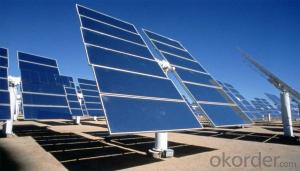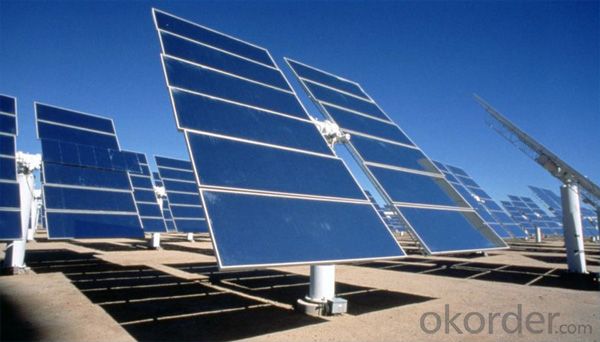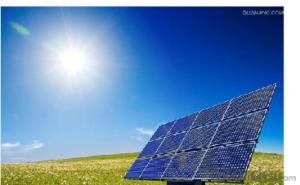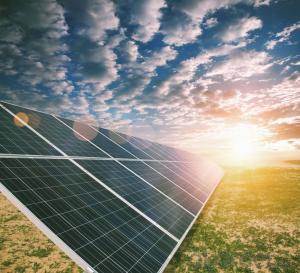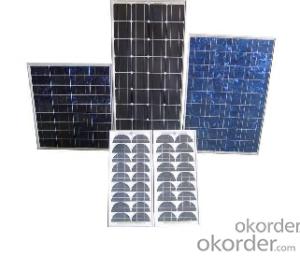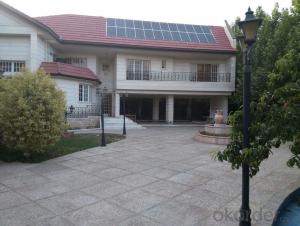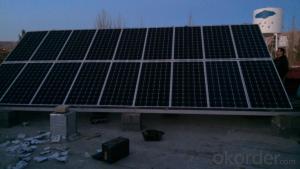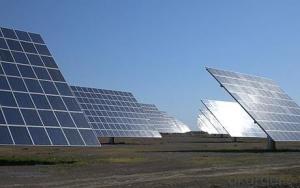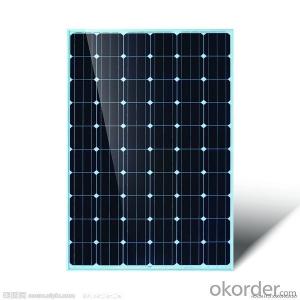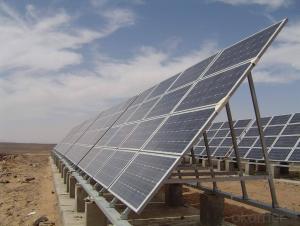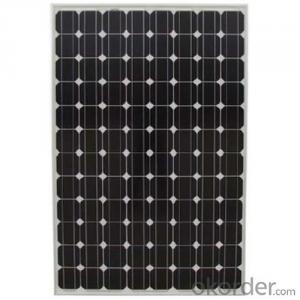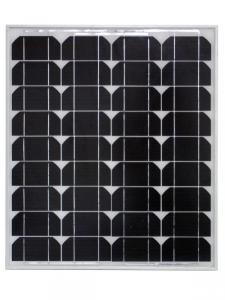Solar Panels Yate - Solar Energy and Solar Power Panels for Landscape Light
- Loading Port:
- China main port
- Payment Terms:
- TT OR LC
- Min Order Qty:
- 10000 watt
- Supply Capability:
- 100000000 watt/month
OKorder Service Pledge
OKorder Financial Service
You Might Also Like
Specification
Production description
Monocrystalline Silicon Solar Panel (60-65W)
• 10 years 90% output warranty
• 20 years 80% output warranty
• High conversion efficiency mono/poly-crystalline amorphous silicon solar cells
• Modules incorporate high performance bypass diodes to minimize the power drop caused by shading
• High transmittance, low-iron tempered glass
• High performance EVA encapsulate to prevent destroying and water.
• AI frame: without screw, corner connection. 8 holes on the frame can be installed easily
• Good performance of preventing from atrocious weather such as wind and hails
• Certifications: CE IEC TUV VDE UL, Class I
Details
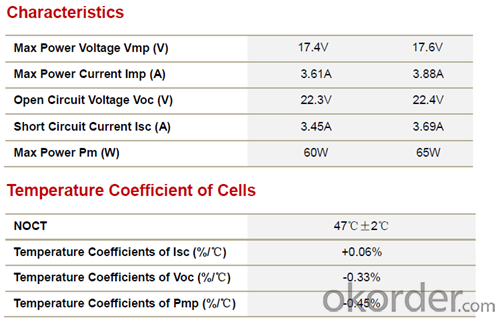
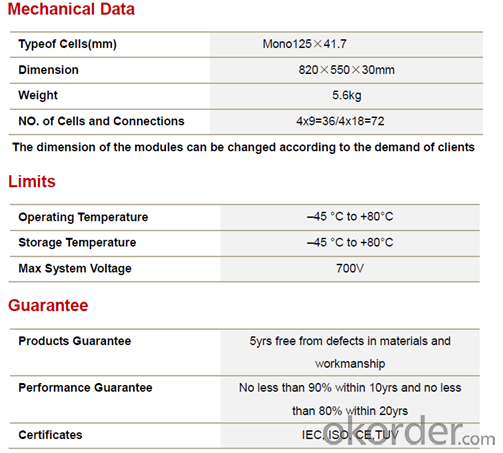

Images
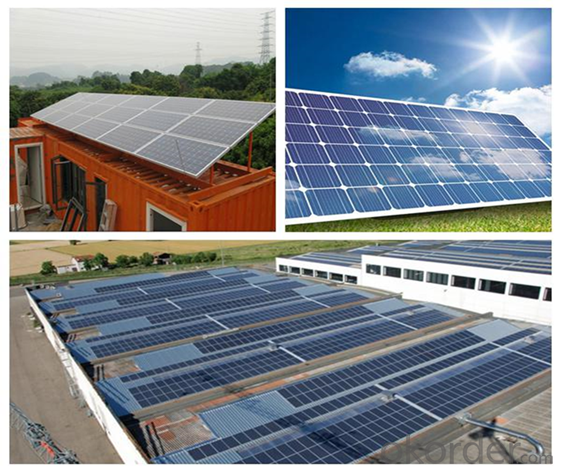
FAQ
We have organized several common questions for our clients,may help you sincerely:
1.What price for each watt?
It depends on the quantity, delivery date and payment terms,
2.How do you pack your products?
We have rich experience on how to pack the panels to make sure the safety on shipment when it arrives at the destination.
- Q: How do solar panels affect the power grid?
- Solar panels can positively impact the power grid by producing clean and renewable energy. When connected to the grid, excess electricity generated by solar panels can be fed back into the system, reducing the overall demand for traditional fossil fuel-based power sources. This not only helps in reducing greenhouse gas emissions but also decreases the strain on the power grid, making it more reliable and sustainable.
- Q: Can solar panels store excess energy?
- No, solar panels themselves cannot store excess energy. However, energy generated by solar panels can be stored in batteries or other storage systems for later use.
- Q: I have a rental property and use a 230-Volt 6-Amp Pool Pump.I would like to use a solar panel to run it when the house is empty, using mains power when guests are here.The building is in the Caribbean so plenty of sun!!I wanted to run it quot;directand not use batteries. Is this possible??What size panel would I need? A DC invertor too??Thanks!!
- Why don't you use the mains as the battery with net metering. That way you don't have to have two pumps, a DC pump for the solar and an AC pump for the mains. A 230 V, 6 A pump draws 3.68 kw. A typical solar panel produces about 400 watts so you would need about 0 solar panels which should run you about $20,000 US. Of course, you may not need to run the pump continuously but in order to use fewer solar panels for sporadic use, you would need the batteries or the net metering. Keep in mind that with the costs of the panels, you will be paying about 38 cents a kwh. Grid power usually costs around 5 cents a kwh.
- Q: I am working on a project and I have to build a house with solar panels. My teacher asked me how would I get solar energy if it is rainy or cloudy? I looked it up but didn't understand. Please help me!!
- Solar panels convert light energy into electrical energy with the photovoltaic process. They work best when perpendicular to the incoming sunlight and with no clouds in bright sunlight. They will work at reduced efficiency if there are clouds or rain, but as long as its not dark, they will still produce some electricity. That is one of the real problems with solar energy, as we expect to have electricity available on demand, regardless of day/night cycles and atmospheric conditions. Storing electricity is very inefficient, so we need hydro, nuclear,or fossil fuel energy to provide firm on demand energy as a base load.
- Q: Can solar panels be installed on senior living facilities?
- Yes, solar panels can be installed on senior living facilities. In fact, many senior living facilities have started incorporating solar panels to reduce energy costs, promote sustainability, and provide clean energy solutions. Installing solar panels can help these facilities become more energy-efficient and reduce their carbon footprint. Additionally, solar energy can contribute to a more comfortable and sustainable living environment for senior residents.
- Q: Can solar panels be used in areas with high levels of bird droppings?
- Yes, solar panels can be used in areas with high levels of bird droppings. However, regular cleaning and maintenance may be required to ensure optimal performance of the panels.
- Q: What is the average size of a solar panel?
- The average size of a solar panel is typically around 65 inches by 39 inches, or approximately 5.4 feet by 3.25 feet. However, the actual size can vary depending on the manufacturer and the specific model of the solar panel.
- Q: Can solar panels be used to power a space station?
- Yes, solar panels can be used to power a space station. In fact, many space stations, including the International Space Station (ISS), utilize solar panels as their primary source of electrical power. These panels convert sunlight into electricity, providing a sustainable and renewable energy source for the space station's various systems and experiments.
- Q: if you know the area of the panel can u calculate for the wattage or voltage of the panel..
- You need to know how many solar cells are in the panel and what is the rated current each cell will produce. This information should be listed on the panel. Each cell will produce from 0.5 to 0.55 volts DC per cell and each cell will produce a current that is dependent on the size of the cell and the type of material the cell is made from. If the cells are connected in series then the voltage of each cell will add together, that is if you have 30 cells connected in series they should generate about 5 to 6.5 volts DC. If each cell generates .2 amps, then you multiply the voltage of 5 volts DC times .2 amps DC equals 8 watts of power. The current of each cell does not add together when you connect the cells in series only the voltage of each cell. If you connect the 30 cells in parallel then the current of each cell adds together but the voltage of each cell does not. That is 0.5 Volts DC times 36 amps equals 8 watts. The power (watts) produced will be the same. See our blog on the products page to see how to connect solar cells in series and in parallel. We also have a PDF file of solar cells and their rated output current sorted by watts per area and their manufacturer.
Send your message to us
Solar Panels Yate - Solar Energy and Solar Power Panels for Landscape Light
- Loading Port:
- China main port
- Payment Terms:
- TT OR LC
- Min Order Qty:
- 10000 watt
- Supply Capability:
- 100000000 watt/month
OKorder Service Pledge
OKorder Financial Service
Similar products
Hot products
Hot Searches
Related keywords
